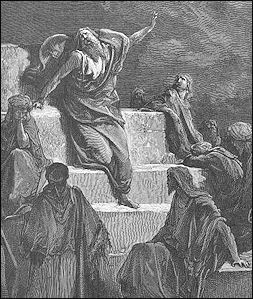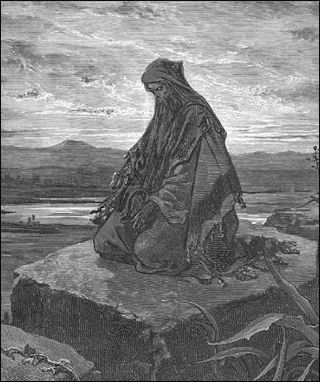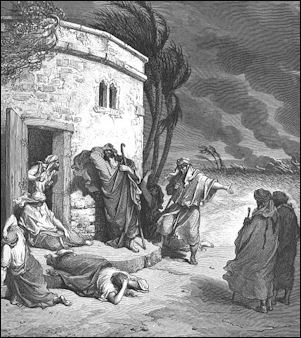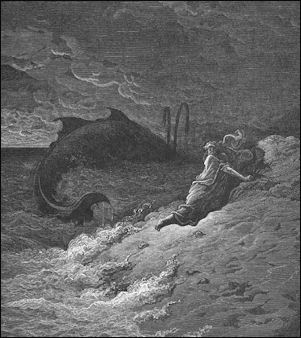Home | Category: Hebrews in Babylon and Persia / Judaism Beliefs / Hebrews in Babylon and Persia / God, Satan, Heaven and Hell
PROPHETS AND RIGHTEOUS MEN IN THE BIBLE

Jeremiah A “prophet” in the biblical sense is not necessarily someone who predicts the future but rather is someone who speaks for God. The Hebrew word for prophet came from a root meaning "to well up, to gush forth." In the Bible prophets were generally men who condemned hypocrisy and spoke the word of God after being summoned by God to speak his message.
Orthodox Jews believe the words of the prophets in the Hebrew Bible are true. Jewish scripture identifies fifty-five prophets, including seven women. These prophets spoke for God and helped to define the relationship between God and His people. A related belief is that Moses was the greatest prophet and that his words are true. [Source: Encyclopedia.com]
The prophets in the Bible were not unlike the oracles who worked at the Greek temples. They were generally associated with the Temple in Jerusalem and were tied with the Temple’s welfare and were distinguished for priests who presided over rituals and were primarily responsible for maintaining religious traditions.
If the prophets appeared today many of them might be declared insane. When asked how he distinguishes between a psychiatric illness and religion vision, a doctor said, “We have no clear cut boundaries. If you use strictly scientific criteria, you can say that all the people in the Bible are mentally ill. They believe such strange things — the visions."
The closest thing to saints in Judaism are “Tzaddikim” — righteous men.A good Jew, or righteous Jew, is one who fulfills his duties with a full heart and incorporates Jewish laws, ethics and morality into his or her everyday life. "Jewish tradition," French writer Marek Halter wrote, "has no saints, only humans. Our sages teach that those whose merits surpass their vices, they are the righteous; that when you save one life, you have saved a universe."
Websites and Resources: Virtual Jewish Library jewishvirtuallibrary.org/index ; Judaism101 jewfaq.org ; torah.org torah.org ; Chabad,org chabad.org/library/bible ; Bible and Biblical History: ; Biblical Archaeology Society biblicalarchaeology.org ; Bible History Online bible-history.com Bible Gateway and the New International Version (NIV) of The Bible biblegateway.com ; King James Version of the Bible gutenberg.org/ebooks ; Jewish History: Jewish History Timeline jewishhistory.org.il/history Jewish History Resource Center dinur.org ; Center for Jewish History cjh.org ; Jewish History.org jewishhistory.org ; Internet Jewish History Sourcebook sourcebooks.fordham.edu ; Christianity: BBC on Christianity bbc.co.uk/religion/religions/christianity ; Christian Classics Ethereal Library www.ccel.org ; Sacred Texts website sacred-texts.com
RECOMMENDED BOOKS:
“The Kings and Prophets of Israel and Judah: From the Division of the Kingdom to the Babylonian Exile (Classic Reprint)” by John Foster Mitchel Amazon.com ;
“A History of the Jewish People During the Babylonian, Persian, and Greek Periods”by Charles Foster Kent Amazon.com ;
“Why the Bible Began: An Alternative History of Scripture and its Origins” by Jacob L. Wright Amazon.com ;
“Commentary on the Torah” by Richard Elliott Friedman Amazon.com ;
“The Holy Bible in English easy to read version” Amazon.com ;
“A History of the Bible: The Story of the World's Most Influential Book”
by John Barton, Ralph Lister, et al. Amazon.com ;
“The Complete Guide to the Bible” by Stephen M. Miller Amazon.com ;
“Oxford Companion to the Bible” by Bruce M. Metzger and Michael David Coogan Amazon.com ;
“Essential Judaism: Updated Edition: A Complete Guide to Beliefs, Customs & Rituals”
by George Robinson Amazon.com ;
“Guide for the Perplexed” by Moses Maimonides, Andrea Giordani, et al. Amazon.com ;
“A History of the Jews” by Paul Johnson, Amazon.com
Important Prophets
Some regard Samuel, the man who predicted David would be a great king, as the first prophet. Other say Moses was the first. Other prominent prophets, include Elijah, who battled for God against the priests of Baal and appeared periodically as God’s angel and messenger; Ezekial, a captive in Babylon who was condemned for the sins of the Jewish people; and Isaiah, who had a vision that God of Israel would one day be worshiped all over the world.
The Jews recognize three “major prophets” — Isaiah, Jeremiah and Ezekiel — and 12 “minor prophets” — Hosea, Joel, Amos, Obadiah, Jonah, Micah, Nahum, Habakkuk, Zephaniah, Haggai, Zechariah and Malachi. Some of these were writers and teachers known as “literary prophets” Amos, spoke against rich man who made their money by exploiting the poor. He said: “Therefore the prudent shall keep silent in that time, for it is an evil time.” Hosea pleaded with people to remain faithful to God;
The character of the prophecies made by the prophets changed in the Old Testament. Those espoused by the early prophets had a moral quality and dealt with things like justice and righteousness and drew connections between suffering and sin for the things such as immoral acts and idolatry (“whoring after strange gods”). Those that came later were directed more towards the future but rather than promise good things to the faithful they dealt more with the responsibilities that were expected of the faithful.
See Moses (Under History) and Daniel and Jeremiah (See Below)
Isaiah

Isaiah Candida Moss wrote in the Daily Beast: If you asked people whom their favorite biblical prophet is, there’s a strong chance they would answer Isaiah. Sure, Moses gets all the accolades, received the tablets, and is the most important; but Isaiah is the prophetic book most quoted by authors of the New Testament. For Christians, Isaiah predicts the coming of the Messiah, the death of Jesus and the Virgin Birth. [Source: Candida Moss, Daily Beast, February 22, 2018]
According to the Book of Isaiah, Isaiah was an eighth-century BCE prophet during the reign of King Hezekiah (one of the few “good kings” who ruled Judah before the Babylonian conquest. In the book of Kings, Hezekiah is described as second only to King David). Isaiah began prophesying during the reign of King Ussiah and appears to have lived through the reigns of Kings Jotham, Ahaz, and the first 14 years of the reign of Hezekiah. He is responsible, among other things, for the earliest biblical description of heaven, which he saw in a vision (Isaiah 6). Many scholars think that Isaiah’s vision of God enthroned in the heavens laid the groundwork for subsequent descriptions of heaven.
Isaiah is influential in Christian circles for his prophecies about the birth of the messiah and the necessity of the messiah’s suffering. Christians liked him so much that they composed the Ascension of Isaiah, an account of his ascent into heaven and martyrdom (by being sawed in half by a wooden saw, which sounds dreadful). The fourth-century Christian theologian Gregory of Nyssa wrote that the prophet Isaiah knew “the mystery of the religion of the Gospel” more perfectly than any of the other prophets. The biblical translator Jerome describes him as an “evangelist,” a term that implies that he is on a par with the authors of the Gospels, and the famous Christian orator John Chrysostom wrote that “the mouth indeed was Isaiah’s, but the oracle was wafted from above.” Andrew Davies, director of the Edward Cadbury Centre at Britain’s University of Birmingham, told The Daily Beast that “without Isaiah we’d be missing some of the most sorrowful but also the most hopeful of all religious poetry and some of the greatest theological innovation of all time.”
Even in his own day, Isaiah was important. Not only did he reside in Jerusalem and have a close relationship with the kings of Judah, but subsequent generations added to his words and work. The majority of scholars believe that the Book of Isaiah should be divided into two if not three sections, with each being attributed to a separate author. The author of the second segment, Second Isaiah (Isaiah 40-55), is thought to have written during the exile and predicted the return of the Jewish people from Babylon to Jerusalem. What the incorporation of these later sections in to the book shows is that Isaiah was important enough that others wanted to use his memory to spread their message.
Did Archaeologists Find Proof of Isaiah’s Existence
In 2018, archaeologists announced in an article published today in Biblical Archaeology Review that they had found the first physical evidence of the existence of the prophet Isaiah. Candida Moss wrote in the Daily Beast: The evidence itself comes in the form of a small piece of clay (an impression left by a seal), a mere 0.4 inches long, which appears to bear the inscription “Isaiah the prophet.” It was unearthed as part of excavations of a previously undisturbed pile of debris at the Ophel excavation in Jerusalem. The dig is headed by Eliat Mazar, who provides a description of the discovery, significance, and translation of the seal in an article published in this month’s issue of BAR. The debris contained figurines, pottery fragments, pieces of ivory, and some clay seal impressions, known as bullae. These impressions were created when the owners of the seals stamped their seals into the soft clay and include the mark of King Hezekiah, previously reported here at The Daily Beast. [Source: Candida Moss, Daily Beast, February 22, 2018]
According to Mazar, “alongside the bullae of Hezekiah… [were] 22 additional bullae… among these is the bulla of “Yesha‘yah[u] Nvy[?],” which is most straightforwardly translated as “Isaiah the Prophet.” Given the importance of Isaiah to religious history, this seal impression is of great significance to Jews and Christians alike. Now, for the first time, we have an example of what might be his signature. Not only is this proof that Isaiah existed (not something scholars truly disputed), but, arguably, evidence of his role in eighth century BCE Jerusalem society. Not everyone who had a seal was of elevated high status (as they were a means of solidifying identity), but the Bible does describe Isaiah as a counselor of the king to whom the monarch would turn for advice. The discovery of his seal impressions in close proximity to that of King Hezekiah confirms the picture of a court prophet that we get from the Bible.
There are, as Mazar acknowledges in her article, some problems with the seal impression. Some of the letters that comprise the wording of the seal appear to have broken off. Additionally, most seals identify their owner with reference to their father “X, the son of Y.” On Mazar’s reading, the Isaiah seal doesn’t follow this format and instead identifies him by profession (i.e., prophet). Mazar weighs these options in her article and begins by considering all of the alternative explanations for the seal.
Robert Cargill, a professor at the University of Iowa, self-described skeptic, and the editor of BAR, told The Daily Beast that this was a “carefully written, responsible article” and that the magazine was careful not to claim definitively to have found the seal of Isaiah. “I appreciated Dr. Mazar’s methodical, responsible approach to this discovery, suggesting critical alternatives to the inscription rather than simply sensationalizing it.”
The discovery itself, Cargill noted, appears pristine: “There is no evidence to suggest that the scientifically excavated and provenanced material from the Ophel excavation was tampered with and/or mixed while it awaited wet-sifting.” He added that while he has personally spent much of his career debunking false archaeological claims, he thinks that Mazar has indeed discovered a seal impression of the prophet Isaiah and “the first archaeological and extra-biblical reference to the prophet.”
Job

Job Hears of His Misfortunes The story of Job in the Old Testament is a vivid illustration of a man retaining his integrity even under the most adverse conditions. Job was a wealthy chieftain in the land of Uz. He was regarded as a righteous and God-fearing man. To test his faith God allowed Satan to bring Job a series of tragedies: the loss of his children and property and an attack of a particularly nasty form of leprosy.
Job’s friend’s told him that God had brought him great misfortune because he is sinner. Firm in his belief that he was righteous, he refused to believe them and called out to God for an explanation. Speaking out of a tornado, God answer him. Realizing that God’s will is beyond his understanding, he bows to God and accepts what has happened to him.
Scholars believe that Job was written around 400 B.C. and may have been based on a real person. It is regarded as a masterpiece of literature as well as parable on suffering. Shakespeare’s “Hamlet” and “Goethe’s Faust” are believed to have been inspired by it.
Jeremiah and Daniel
Jeremiah was not very popular in his time, around 700 B.C. Before the Babylonian conquest he predicted that great misfortunes would befall the Jews. He was called a traitor because the placed God above the interest of the Jewish king. In 1986, archaeologists discovered a seal that belonged to Baruch, son of Neriah, a scribe who recorded the prophecies of Jeremiah in 587 B.C. . The expression "Can a leopard change his spots?" is first attributed to Jeremiah. In the Jeremiah 13:23 in the Old Testament, Jeremiah says, "Can the Ethiopian change his skin, or the leopard his spots? then may ye also do good, that are accustomed to do evil."
Daniel is a hero in a Biblical book that bears his name. A captive brought from Jerusalem to Babylon, he won favor with King Nebuchadnezzar for his wisdom and ability to predict dreams. He rose to a high position in the Babylonian kingdom. When the Babylonians were defeated by the Persians, Daniel retained his position but was ousted by jealous princes, who threw him in the lion’s den, where he miraculously escaped death.
Jonah and the Whale
The Old Testament book of Jonah is about a believer who questions his faith when it seems that God has changed his mind in a very human way. In the book Jonah is swallowed by a whale, then “vomited out” after an act of God. But the same God promised to bring destruction on the city of Nivenah because of the high number of sinner’s there but goes back on his word because Nivenah contains “more than sixscore person who cannot discern between their right hand and their left hand; and also much cattle” — or in other words innocent children and animals. God’s decision makes Jonah “angry even upon death.”
Candida Moss wrote in the Daily Beast: There’s a famous story in the Bible in which Jonah, a reluctant prophet, attempts to flee from God’s call. Thinking that geographical distance will solve his problem, Jonah gets on a boat and sets off across the Mediterranean for Tarshish (in the Western Mediterranean). As most Sunday school attendees know, things do not go to plan. There’s a terrible storm, the sailors draw lots to see who among them is responsible for incurring divine wrath, and they end up throwing Jonah overboard. From there, things only get worse for Jonah. He is swallowed by a big fish, spends three days in its belly, and, repentant, is finally regurgitated onto the shore.[Source: Candida Moss, Daily Beast, July 28, 2018]
For both ancient and modern people it’s a remarkably popular tale. Ancient Christians used to adorn the walls of catacombs in Rome with artwork showing Jonah’s deliverance. They saw Jonah’s three-day captivity in the fish as a prefiguration of both Jesus’ death and resurrection and also the eventual resurrection of the Christian dead.
But Why Were Ancient People So Afraid Whales When They are Hardly Any in the Mediterranean

Jonah Spewed Forth by the Whale But one element puzzles modern readers: even if you grant the existence of miracles, where did the whale (people almost always think the fish is a whale) in the Mediterranean come from? There are hardly any whales living in the Mediterranean Sea. In other Biblical passages God’s adversary is also described as some kind of sea creature. Sometimes referred to as Rahab and sometimes as Leviathan, this primordial monster was an adversary of God. These ancient peoples had never seen Jaws; given the relatively predator-free status of the Mediterranean, what are they so afraid of?
In a study published in 2018 in the Proceedings of the Royal Society B by an international team of researchers, offers the first evidence that there were once whales in the Mediterranean. In their article, the team, headed up by Ana Rodrigues of the Université de Montpelier, analyzed the DNA in a rare set of whale bones from Roman and pre-Roman sites in the Strait of Gibraltar. The results identified two species of whale: right whales (Eubalaena glacialis) and Grey whales (Eschrichtius robustus). Their article concludes that roughly two thousand years ago the Mediterranean was a calving ground.
If accurate, this study can explain why it was that ancient peoples who lived along the Mediterranean were so afraid of sea monsters, and also why we no longer see these “monsters” today. This in turn can help solve one of the biggest marine puzzles in the Bible: what did people imagine swallowed Jonah? Christian catacomb art of the “fish” depicts it as a kind of undersized water dragon with bunny ears. So while Northern Europeans might have always assumed it was a whale, this wasn’t always the case, and only now seems credible. The discovery also sheds some light on what people may have thought God’s aquatic adversary actually was. The Bible uses the language of fierce animals like lions to describe the power of the Devil. Now to this thesaurus of demonic imagery we can add a new, usually beloved figure: the whale.
Image Source: Wikimedia Commons
Text Sources: Internet Jewish History Sourcebook sourcebooks.fordham.edu “World Religions” edited by Geoffrey Parrinder (Facts on File Publications, New York); “ Encyclopedia of the World’s Religions” edited by R.C. Zaehner (Barnes & Noble Books, 1959); “Old Testament Life and Literature” by Gerald A. Larue, New International Version (NIV) of The Bible, biblegateway.com; Wikipedia, Live Science, Archaeology magazine, National Geographic, BBC, New York Times, Washington Post, Los Angeles Times, Smithsonian magazine, Times of London, The New Yorker, Reuters, AP, AFP, Lonely Planet Guides, and various books and other publications.
Last updated March 2024
